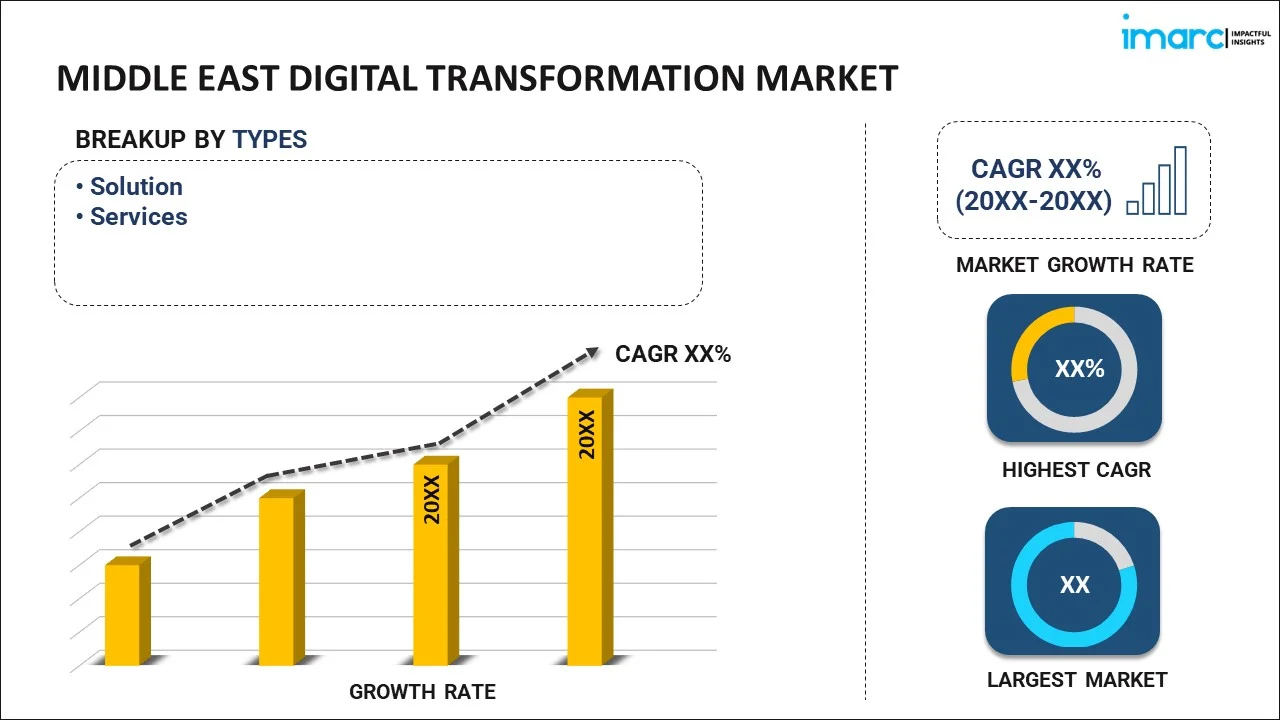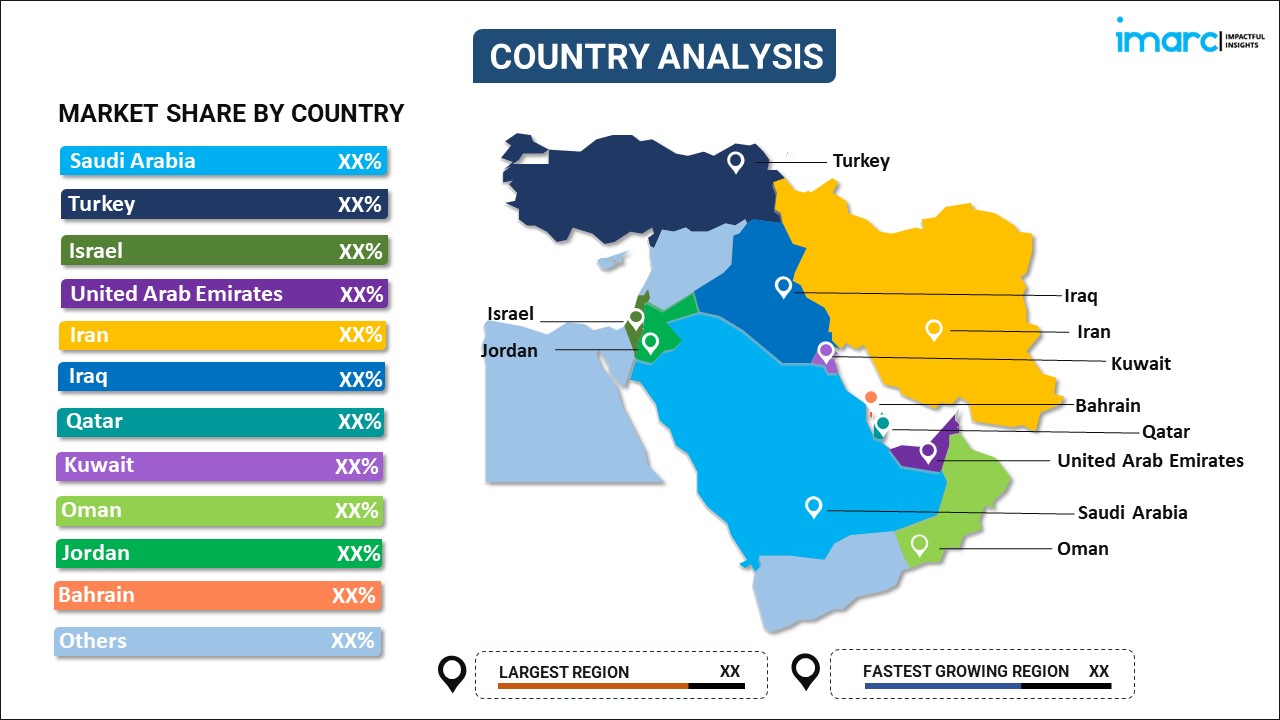
Middle East Digital Transformation Market Report by Type (Solution, Services), Deployment Mode (Cloud-based, On-premises), Enterprise Size (Large Enterprises, Small and Medium-sized Enterprises), End Use Industry (BFSI, Manufacturing and Retail, Government, Healthcare, IT and Telecom, and Others), and Country 2025-2033
Market Overview:
Middle East digital transformation market size is projected to exhibit a growth rate (CAGR) of 15.2% during 2025-2033. The increasing application of digital technologies that often enable cost savings through process automation, improved efficiency, and reduced operational expenses, is driving the market.
|
Report Attribute
|
Key Statistics
|
|---|---|
|
Base Year
|
2024 |
|
Forecast Years
|
2025-2033
|
|
Historical Years
|
2019-2024
|
| Market Growth Rate (2025-2033) | 15.2% |
Digital transformation is the comprehensive integration of digital technologies into all aspects of an organization, fundamentally changing how it operates and delivers value to its customers. It involves leveraging technology to streamline processes, enhance efficiency, and drive innovation. Key components include adopting cloud computing, implementing data analytics, embracing artificial intelligence, and optimizing digital communication channels. The goal is to create a more agile, responsive, and customer-centric organization that can adapt to the rapidly evolving digital landscape. Digital transformation is not just about technology; it necessitates a cultural shift, requiring organizations to foster a mindset of continuous learning and adaptation. Successful digital transformation enables businesses to stay competitive in the digital age by harnessing the power of technology to meet customer expectations, improve decision-making, and create new business models.
Middle East Digital Transformation Market Trends:
The digital transformation market in the Middle East is propelled by several key drivers, each playing a pivotal role in reshaping industries and organizations. Firstly, the escalating demand for enhanced customer experiences acts as a catalyst for digital transformation initiatives. As businesses strive to meet evolving consumer expectations, the integration of advanced technologies becomes imperative. Furthermore, the ubiquity of data and the imperative to derive actionable insights drive organizations toward digital transformation. With the exponential growth of data, businesses recognize the need to harness its potential for strategic decision-making and innovation. In addition to this, the competitive landscape compels companies to adopt digital transformation as a survival strategy. Industries are witnessing a paradigm shift where digital natives and agile startups disrupt traditional markets, urging established players to adapt swiftly. Simultaneously, the push for operational efficiency and cost optimization propels organizations towards automation and process digitization. The quest for agility and flexibility in responding to dynamic market conditions is another driving force, emphasizing the need for adaptable and responsive business models. Moreover, regulatory requirements and compliance standards, which contribute to the momentum of digital transformation, compelling industries to invest in technologies that ensure adherence to legal frameworks, are expected to drive the market in the Middle East during the forecast period.
Middle East Digital Transformation Market Segmentation:
IMARC Group provides an analysis of the key trends in each segment of the market, along with forecasts at the regional and country levels for 2025-2033. Our report has categorized the market based on type, deployment mode, enterprise size, and end use industry.
Type Insights:

- Solution
- Analytics
- Cloud Computing
- Mobility
- Social Media
- Others
- Services
- Professional Services
- Integration and Implementation
The report has provided a detailed breakup and analysis of the market based on the type. This includes solution, (analytics, cloud computing, mobility, social media, and others) and services (professional services and integration and implementation).
Deployment Mode Insights:
- Cloud-based
- On-premises
A detailed breakup and analysis of the market based on the deployment mode have also been provided in the report. This includes cloud-based and on-premises.
Enterprise Size Insights:
- Large Enterprises
- Small and Medium-sized Enterprises
A detailed breakup and analysis of the market based on the enterprise size have also been provided in the report. This includes large enterprises and small and medium-sized enterprises.
End Use Industry Insights:
- BFSI
- Manufacturing and Retail
- Government
- Healthcare
- IT and Telecom
- Others
A detailed breakup and analysis of the market based on the end use industry have also been provided in the report. This includes BFSI, manufacturing and retail, government, healthcare, IT and telecom, and others.
Country Insights:

- Saudi Arabia
- Turkey
- Israel
- United Arab Emirates
- Iran
- Iraq
- Qatar
- Kuwait
- Oman
- Jordan
- Bahrain
- Others
The report has also provided a comprehensive analysis of all the major regional markets, which include Saudi Arabia, Turkey, Israel, United Arab Emirates, Iran, Iraq, Qatar, Kuwait, Oman, Jordan, Bahrain, and Others.
Competitive Landscape:
The market research report has also provided a comprehensive analysis of the competitive landscape in the market. Competitive analysis such as market structure, key player positioning, top winning strategies, competitive dashboard, and company evaluation quadrant has been covered in the report. Also, detailed profiles of all major companies have been provided.
Middle East Digital Transformation Market Report Coverage:
| Report Features | Details |
|---|---|
| Base Year of the Analysis | 2024 |
| Historical Period | 2019-2024 |
| Forecast Period | 2025-2033 |
| Units | Million USD |
| Scope of the Report | Exploration of Historical and Forecast Trends, Industry Catalysts and Challenges, Segment-Wise Historical and Predictive Market Assessment:
|
| Types Covered |
|
| Deployment Modes Covered | Cloud-based, On-premises |
| Enterprise Sizes Covered | Large Enterprises, Small and Medium-sized Enterprises |
| End Use Industries Covered | BFSI, Manufacturing and Retail, Government, Healthcare, IT and Telecom, Others |
| Countries Covered | Saudi Arabia, Turkey, Israel, United Arab Emirates, Iran, Iraq, Qatar, Kuwait, Oman, Jordan, Bahrain, Others |
| Customization Scope | 10% Free Customization |
| Post-Sale Analyst Support | 10-12 Weeks |
| Delivery Format | PDF and Excel through Email (We can also provide the editable version of the report in PPT/Word format on special request) |
Key Questions Answered in This Report:
- How has the Middle East digital transformation market performed so far and how will it perform in the coming years?
- What has been the impact of COVID-19 on the Middle East digital transformation market?
- What is the breakup of the Middle East digital transformation market on the basis of type?
- What is the breakup of the Middle East digital transformation market on the basis of deployment mode?
- What is the breakup of the Middle East digital transformation market on the basis of enterprise size?
- What is the breakup of the Middle East digital transformation market on the basis of end use industry?
- What are the various stages in the value chain of the Middle East digital transformation market?
- What are the key driving factors and challenges in the Middle East digital transformation?
- What is the structure of the Middle East digital transformation market and who are the key players?
- What is the degree of competition in the Middle East digital transformation market?
Key Benefits for Stakeholders:
- IMARC’s industry report offers a comprehensive quantitative analysis of various market segments, historical and current market trends, market forecasts, and dynamics of the Middle East digital transformation market from 2019-2033.
- The research report provides the latest information on the market drivers, challenges, and opportunities in the Middle East digital transformation market.
- Porter's five forces analysis assist stakeholders in assessing the impact of new entrants, competitive rivalry, supplier power, buyer power, and the threat of substitution. It helps stakeholders to analyze the level of competition within the Middle East digital transformation industry and its attractiveness.
- Competitive landscape allows stakeholders to understand their competitive environment and provides an insight into the current positions of key players in the market.
Need more help?
- Speak to our experienced analysts for insights on the current market scenarios.
- Include additional segments and countries to customize the report as per your requirement.
- Gain an unparalleled competitive advantage in your domain by understanding how to utilize the report and positively impacting your operations and revenue.
- For further assistance, please connect with our analysts.
 Inquire Before Buying
Inquire Before Buying
 Speak to an Analyst
Speak to an Analyst
 Request Brochure
Request Brochure
 Request Customization
Request Customization




.webp)




.webp)












